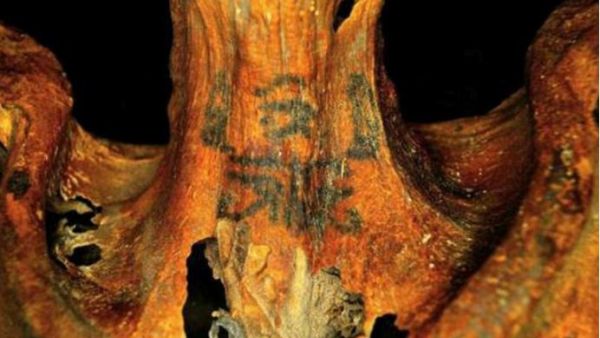A woman who tattooed her body during the time of the pharaohs was a highly respected religious leader, experts have revealed.
The body, which was found in Deir el Medina near Egypt's Valley of the Kings, is covered with around 30 ancient tattoos.
Scientists believe the Deir el Medina mummy lived sometime between 1300 and 1070 BC and would have been as young as 25 years old when she died.
'Scientific and archaeological studies reveal that it is the mummy of a woman who probably lived between 1300 and 1070 BC and died when her age ranged between 25 and 34 years,' Mustafa el Waziri, secretary general of the supreme council of Antiques, told International News.
The tattoos include depictions of cows on her arm, baboons on her neck and even a lotus flower on her hip.
Experts say these prestigious tattoos show the mummy 'belongs to a woman who enjoyed an important religious status throughout her life'.
She also has wadjet eyes on her neck, shoulders and back which were possibly symbols to project against evil.
'Any angle that you look at this woman, you see a pair of divine eyes looking back at you,' said bioarchaeologist Anne Austin of Stanford University in California in a Nature article.
'Those found so far in other mummies of ancient Egypt present simple squiggles as points or small lines but never scenes or figures like those we find here,' Mr el Waziri said.
The cows are associated with the goddess Hathor, which was a prominent deity in ancient Egypt.
Tattoos on her throat and arm could have given the young woman magical power when she sang or played during rituals.
Her body was found four years ago by researchers from the French Institute of Oriental Archeology (IFAO) which is based in Cairo.
Dr Austin uncovered the tattoos on the Deir el Medina mummy by using infrared lighting and an infrared sensor.
Some of the mummy's skin was so darkened by mummification the tattoos were not visible to the human eye.
Dr Austin says creating the tattoos 'would've been very time consuming, and in some areas of the body, extremely painful'.
The fact she had it done so many times despite this shows how important she believed it was.
Earlier this year the world's earliest figurative tattoos were discovered on 5,000-year-old Egyptian mummies at the British Museum.
The tattoos are of a wild bull and a Barbary sheep on the upper-arm of a male mummy, and S-shaped motifs on the upper-arm and shoulder of a female.
The find dates tattoos containing imagery rather than geometric patterns to 1,000 years earlier than previously thought.
Researchers say the discovery 'transforms' our understanding of how people lived during this period.
The tattoos were found on male and female 'Gebelein' mummies.
The 5,000-year-old male mummy, which is naturally preserved, has been one of the star displays at the British Museum, visited by millions each year, since its discovery in a cemetery over 100 years ago.
Previous research revealed that the man, known as Gebelein Man A, died a violent death between the ages of around 18 to 21, from a stab wound to his back.
But dark smudges on his arm, which appeared as faint markings under natural light, have now been examined.
The oldest known tattoos in the world were discovered on Ötzi the Iceman, dating from around the same time, but they are purely geometric.
This article has been adapted from its original source.








